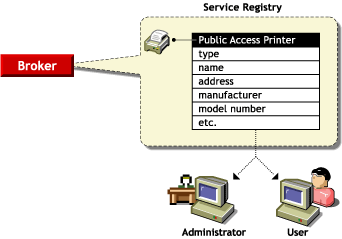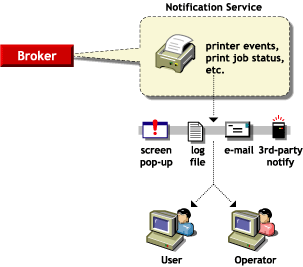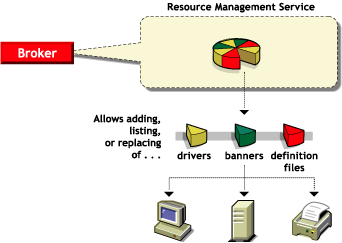

  |
The Broker provides three network support services not previously available in NetWare: the Service Registry Service (SRS), Event Notification Service (ENS), and Resource Management Service (RMS).
While these services are invisible to end users, network administrators should be aware of them. NDPS uses these services in the following ways:
Service Registry Service. The Service Registry allows public access printers to advertise themselves so that administrators and users can find them. This service maintains information about device type, device name, device address, and device-specific information such as the manufacturer and model number. See Understanding the Service Registry Service.
Event Notification Service. This service allows printers to send customizable notifications to users and operators about printer events and print job status. The Notification Service supports a variety of delivery methods including NetWare pop-up, log file, e-mail, and programmatic. See Understanding the Event Notification Service.
Resource Management Service. This service allows resources to be installed in a central location and then downloaded to clients, printers, or any other entity on the network that needs them. The Resource Management Service supports adding, listing, and replacing resources including printer drivers, printer definition (PDF) files, banners, and fonts. See Understanding the Resource Management Service.
For information about other major NDPS components, see the following:
The Service Registry allows public access printers to advertise themselves so that administrators and users can find them. This service maintains information about device type, device name, device address, and device-specific information such as the printer manufacturer and model number.

Before Novell Distributed Print Services (NDPS), each printer had to periodically advertise its availability through the Service Advertising Protocol (SAP), which was effective but created a lot of traffic on the wire.
The Service Registry Service helps minimize the network traffic problem created by many printers advertising through the SAP. (For information on turning off the SAP, see the documentation for your printer.) When you attach a public access printer to the network, it registers with the SRS. When an application or user wants to use a printer, it can contact an SRS and retrieve a list of all registered printers on the network.
NOTE: For IPX, the SRS uses SAP type 8202; for IP environments, it uses Multicast.
Through the SRS, plug-and-print public access printers, as well as those created manually, are immediately made available to users.
If there are multiple Service Registries running on the network, they synchronize automatically. This synchronization allows users to choose public access printers anywhere on the network.
In addition to printer information, the SRS also maintains lists of other services available, such as Event Notification Services and Resource Management Services. For more information, see Understanding the Event Notification Service, Understanding the Resource Management Service, and Enabling and Disabling Brokered Services.
Novell Distributed Print Services (NDPS) printers can be configured to provide event notification regarding print jobs and printer status. Administrators can configure event notification for interested parties, that is, non-job-owners that you wish to be notified of a defined printer or server event that occurs during the processing and printing of a job. See Configuring Interested-Party Notification for more information.

The Event Notification service supports both consumers of events (users) and suppliers of events (printers). Users can register with the ENS by identifying the types of events they want to be notified about, while the printer can register the kinds of events it is capable of reporting. For example, the administrator for a specific printer (by default a Manager of that printer) can designate an Operator to be notified if the printer runs out of paper or if the toner is low. Similarly, users can be notified when their jobs have finished printing.
The availability of the following delivery options is dependent on which of them you have enabled. (See Enabling Event Notification Delivery Methods for more information.)
Pop-up notification. Messages will pop up on the screen for individuals designated to receive them. (Pop-up notification is always enabled when the ENS is enabled.)
SMTP notification. Messages will be sent to the recipient through SMTP (Simple Mail Transfer Protocol) in IP-based systems.
Log file notification. Messages are written to a file at a designated location on a NetWare server that the recipient has rights to.
Programmatic notification. Two programmatic notification delivery methods are shipped with NDPS: SPXTM and RPC.
The open architecture of NDPS allows third parties to develop additional delivery methods as well.
NDPS is enabled to work with SNMP. In addition, some third-party gateways are SNMP-enabled independently of the NDPS software.
For more information about other brokered services, see the following:
This service allows resources to be installed in a central location and then downloaded to clients, printers, or any other entity on the network that needs that resource. It provides a single place where a variety of file types are stored for immediate access by Novell Distributed Print Services (NDPS). The Resource Management Service (RMS) supports adding, listing, and replacing resources including printer drivers, printer definition files (PDFs), banners, and fonts.

The Resource Management Service allows you to add, list, and replace the following resources:
Some of the benefits offered by the Resource Management Service include
For more information about other brokered services, see the following:
Although the distribution of your Brokers is not really a critical issue initially, you will probably want to give some thought to this issue as you do your preliminary planning. You will not need to create a Broker on all of your servers, but you will want your Brokers sufficiently well distributed so that your brokered services (Service Registry Service, Event Notification Service, and Resource Management Service) will be readily available on the system when needed. When possible, you should run the Broker on the same server as the NDPS Manager.
As you gain experience with your new system, you might want to add or delete Brokers to optimize the efficiency of your system or to store your brokered resources (maintained in the Resource Management database) where you want them.
Given Novell's minimum design requirements, at least one Broker object should be created at each physical WAN location. To clarify this statement, let's take a quick look at the three services offered by the Broker object: Service Registry Service (SRS), Event Notification Service (ENS), and Resource Management Service (RMS). These services are transparent to end users, administrators must be aware of them and understand how they affect printing, LAN traffic, and the minimum implementation requirements needed.
Service Registry Service: The Service Registry Service allows public access printers to advertise themselves so that end users can find them. This service maintains information about device type, device name, device address, and device-specific information such as the printer manufacturer and model number. For more information, see Understanding the Service Registry Service.
The following table summarizes the issues and recommendations regarding SRS.
Event Notification Service: NDPS printers can be configured to provide event notification of print jobs and printer status. Administrators can configure event notification for all interested parties. That is, non-job owners as well can be notified of a defined printer or server event which occurs during the processing and printing of a job. For more information, see Understanding the Event Notification Service
Here are the issues and recommendations relating to ENS.
Resource Management Service: This service allows resources to be installed in a central location and then downloaded to clients, printers, or any other entity on the network that needs that resource. It provides a single place where a variety of file types are stored for immediate access by NDPS. For more information, see Understanding the Resource Management Service.
  |